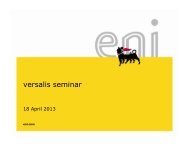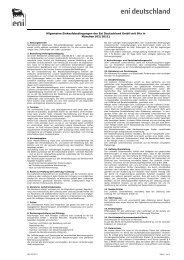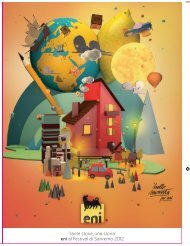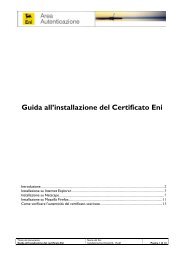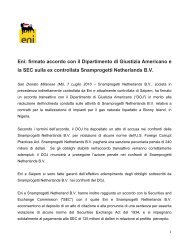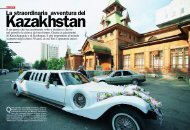È in corso il restauro conservativo del Duomo di Milano. Un ... - Eni
È in corso il restauro conservativo del Duomo di Milano. Un ... - Eni
È in corso il restauro conservativo del Duomo di Milano. Un ... - Eni
Create successful ePaper yourself
Turn your PDF publications into a flip-book with our unique Google optimized e-Paper software.
FOCUS<br />
apostoli, <strong>di</strong> angeli e <strong>di</strong> demoni che popolano le pag<strong>in</strong>e sacre<br />
si è cristallizzata <strong>in</strong> bassor<strong>il</strong>ievi e statue, offrendo così<br />
una straord<strong>in</strong>aria Biblia pauperum, ossia una Bibbia<br />
dest<strong>in</strong>ata ai “poveri”, a chi non sapeva leggere. <strong>Un</strong>a Bibbia<br />
che <strong>di</strong>ventava, poi, colma <strong>di</strong> colori e <strong>di</strong> iridescenze<br />
nelle <strong>di</strong>stese gran<strong>di</strong>ose <strong>del</strong>le vetrate, anch’esse animate<br />
da scene sacre.<br />
Mani nob<strong>il</strong>i e mani modeste hanno creato per secoli<br />
questo brulicare <strong>di</strong> figure <strong>in</strong>trecciando fede e arte, spiritualità<br />
e folclore, culto e vita quoti<strong>di</strong>ana. In questa luce<br />
emerge la seconda funzione <strong>del</strong> <strong>Duomo</strong>: esso è per<br />
eccellenza <strong>il</strong> più alto simbolo civico. Lo è <strong>in</strong>nanzitutto<br />
perché ha scan<strong>di</strong>to gli ultimi sei secoli <strong>del</strong>la storia<br />
cittad<strong>in</strong>a con la sua bellezza, sempre <strong>in</strong> crescita, quasi<br />
fosse un vero e proprio corpo vivente. Infatti, <strong>il</strong> famoso<br />
detto popolare che considera “<strong>in</strong>-f<strong>in</strong>ita” la “fabbrica”<br />
<strong>del</strong> <strong>Duomo</strong> attesta la vitalità <strong>di</strong> un tempio che segue <strong>il</strong><br />
pulsare stesso <strong>del</strong>le vicende <strong>del</strong>la città. Eppure questa<br />
cont<strong>in</strong>ua metamorfosi non impe<strong>di</strong>sce che agli occhi <strong>del</strong><br />
m<strong>il</strong>anese (ma spesso anche <strong>del</strong> turista <strong>di</strong>stratto o frettoloso)<br />
<strong>il</strong> <strong>Duomo</strong> sia “tra i meravej quella <strong>di</strong> sett”, ossia<br />
la settima meraviglia <strong>del</strong> mondo, come <strong>di</strong>chiarava Carlo<br />
Porta <strong>in</strong> una <strong>del</strong>le sue Poesie m<strong>il</strong>anesi (12, 4).<br />
Il m<strong>il</strong>anese o <strong>il</strong> visitatore esterno, pur nel frastuono urbano<br />
attuale e nella cort<strong>in</strong>a permanente <strong>di</strong> smog che è ormai<br />
<strong>il</strong> sudario imposto al <strong>Duomo</strong> e a M<strong>il</strong>ano, appena s’affaccia<br />
su quella piazza ripete <strong>il</strong> gesto e prova la stessa<br />
emozione che Manzoni aveva attribuito al suo Renzo,<br />
giunto per la prima volta <strong>in</strong> città: “Salito su uno <strong>di</strong> quei<br />
valichi sul terreno più elevato vide quella gran macch<strong>in</strong>a<br />
<strong>del</strong> <strong>Duomo</strong> sola sul piano, come se, non <strong>di</strong> mezzo a una<br />
città, ma sorgesse <strong>in</strong> un deserto; e si fermò sui due pie<strong>di</strong>,<br />
<strong>di</strong>menticando i suoi guai, a contemplare da lontano quell’ottava<br />
meraviglia, <strong>di</strong> cui aveva sentito parlare f<strong>in</strong> da<br />
bamb<strong>in</strong>o” (Promessi Sposi XI). La centralità <strong>di</strong> questa<br />
che, per Manzoni, è <strong>in</strong>vece l’ottava meraviglia <strong>del</strong> mondo,<br />
non è dunque solo religiosa ma anche civ<strong>il</strong>e. <strong>È</strong> <strong>il</strong> cuore<br />
<strong>del</strong>la città; è quasi la conferma sperimentale <strong>del</strong>la celebre<br />
tesi <strong>del</strong> “centro” che, secondo <strong>il</strong> famoso stu<strong>di</strong>oso Mircea<br />
Eliade, era <strong>il</strong> primo simbolo umano e sociale <strong>del</strong>l’uomo<br />
<strong>del</strong>le orig<strong>in</strong>i, cioè uno spazio sacro capace però <strong>di</strong> organizzare<br />
tutto <strong>il</strong> resto <strong>del</strong>l’orizzonte <strong>in</strong> un progetto <strong>di</strong><br />
senso e <strong>di</strong> armonia.<br />
Infatti, chi avesse la fortuna <strong>di</strong> sorvolare con un elicottero<br />
<strong>il</strong> nucleo urbano <strong>di</strong> M<strong>il</strong>ano o, più semplicemente, gettasse<br />
uno sguardo su una mappa <strong>del</strong>la città, scoprirebbe subito<br />
che le ra<strong>di</strong>ali <strong>del</strong>le sue vie convergono verso quel centro<br />
che è costituito dal <strong>Duomo</strong>, <strong>il</strong> cuore <strong>del</strong>la vita e <strong>del</strong>l’ord<strong>in</strong>amento<br />
armonico <strong>di</strong> M<strong>il</strong>ano. <strong>È</strong> per questo che ogni m<strong>il</strong>anese,<br />
credente o agnostico, <strong>in</strong><strong>di</strong>geno o “importato”, sperimenta<br />
sempre un fremito <strong>di</strong> fronte alla “bella Madun<strong>in</strong>a<br />
che te br<strong>il</strong>let de luntan…”. <strong>Un</strong> sentimento che uno scrittore<br />
m<strong>il</strong>anese, Em<strong>il</strong>io De Marchi (1851-1901) aveva tratteggiato<br />
nella “prosa cadenzata” El noster Domm, evocando<br />
<strong>il</strong> turbamento <strong>di</strong> chi sta per tornare nella città da tempo lasciata.<br />
Già a quaranta miglia da M<strong>il</strong>ano com<strong>in</strong>cia a sbirciare<br />
dal f<strong>in</strong>estr<strong>in</strong>o <strong>del</strong> treno per cercare <strong>di</strong> <strong>in</strong>travedere tra gli<br />
alberi e la nebbia <strong>del</strong>le risaie quel simbolo amato, “la Madonn<strong>in</strong>a<br />
benedetta <strong>del</strong> noster Domm”. E appena essa appare<br />
sotto un raggio <strong>di</strong> sole, le lacrime affiorano agli occhi,<br />
<strong>il</strong> cuore batte nel petto e si <strong>di</strong>venta come ragazz<strong>in</strong>i emo-<br />
6<br />
zionati (“el coeur el batt come on magnan… e allora se<br />
piang… se piang come bagaj”).<br />
Gianfranco Ravasi, monsignore e protonotario apostolico, è<br />
prefetto <strong>del</strong>la Biblioteca Ambrosiana <strong>di</strong> M<strong>il</strong>ano, docente <strong>di</strong><br />
esegesi biblica alla Facoltà Teologica <strong>del</strong>l’Italia Settentrionale<br />
e membro <strong>del</strong>la Pontificia commissione biblica.<br />
<strong>Eni</strong>’s Way<br />
womanhood”, accord<strong>in</strong>g to the poetic description by Father<br />
David M. Turoldo – the forest of its 135 spires, the<br />
thousands of statues, the bloom of fly<strong>in</strong>g buttresses, the<br />
magic of ornamental tracery and the power of its buttresses,<br />
po<strong>in</strong>t toward that topmost figure which has become the<br />
symbol of M<strong>il</strong>an, more so than any other monument <strong>in</strong> town,<br />
<strong>in</strong>clud<strong>in</strong>g the famous ‘alla Scala’ Opera house.<br />
The <strong>Duomo</strong> serves both a historical and a symbolic purpose for the<br />
city of M<strong>il</strong>an, with its Madonn<strong>in</strong>a stand<strong>in</strong>g 108.50 meters from the<br />
ground. First of all, it is par excellence a religious emblem,<br />
entrusted to art and piety. When we step <strong>in</strong>side, the verticality of<br />
the Gothic steeps you <strong>in</strong>to <strong>in</strong>f<strong>in</strong>ity and the <strong>in</strong>tensity of s<strong>il</strong>ence, our<br />
eyes purified from the vulgar ostentation of the commercial<br />
products besieg<strong>in</strong>g the square outside and our ears set free from<br />
noise and mundane chatt<strong>in</strong>g. In<br />
the nave and aisles, the s<strong>il</strong>ence<br />
is broken only by the gentle and<br />
fluid harmony of the Ambrosian<br />
‘canto fermo’ (pla<strong>in</strong> song), an<br />
older and more austere version<br />
of the Gregorian chant: its<br />
essentiality makes room only for<br />
harmonic spirals rem<strong>in</strong>d<strong>in</strong>g of<br />
the sw<strong>in</strong>gs of the <strong>in</strong>cense<br />
thurible (which <strong>in</strong> the rite of the<br />
M<strong>il</strong>an Church is rotated <strong>in</strong> a<br />
<strong>di</strong>fferent way from the<br />
“subsultory” gestures of the<br />
Roman rite) and leaves an<br />
unforgettable mark on your soul.<br />
Your eyes, <strong>in</strong>stead, are<br />
enraptured by the solemn<br />
liturgy which is tak<strong>in</strong>g place on<br />
the altar. Once aga<strong>in</strong> the<br />
Ambrosian rite proves to be<br />
someth<strong>in</strong>g unique, turn<strong>in</strong>g<br />
M<strong>il</strong>an’s <strong>di</strong>ocese <strong>in</strong>to a holy<br />
island whose very ancient<br />
RITO AMBROSIANO.<br />
Il <strong>Duomo</strong> è <strong>il</strong> cuore<br />
<strong>del</strong>la tra<strong>di</strong>zione liturgica<br />
ambrosiana, che risale al periodo<br />
<strong>di</strong> Gregorio Magno (sec IV-V).<br />
Le <strong>di</strong>fferenze con <strong>il</strong> rituale<br />
romano riguardano <strong>il</strong> Battesimo<br />
con immersione, l’Avvento <strong>di</strong> sei<br />
settimane anziché quattro<br />
e la Quaresima più breve<br />
<strong>di</strong> quattro giorni. Peculiare anche<br />
<strong>il</strong> canto ambrosiano <strong>in</strong> st<strong>il</strong>e<br />
greco-bizant<strong>in</strong>o che<br />
si contrappone al canto<br />
gregoriano <strong>del</strong>la liturgia romana.<br />
THE AMBROSIAN RITE.<br />
The <strong>Duomo</strong> is the heart of the<br />
Ambrosian liturgical tra<strong>di</strong>tion,<br />
dat<strong>in</strong>g back to the time of Pope<br />
Gregory the Great (IV-V century).<br />
The <strong>di</strong>fferences from the Roman<br />
ritual concern the Baptism by<br />
immersion, Advent last<strong>in</strong>g six rather<br />
than four weeks, and a four-day<br />
shorter Lent time. Also typical of<br />
M<strong>il</strong>an is the Ambrosian chant <strong>in</strong> the<br />
greek-byzant<strong>in</strong>e tra<strong>di</strong>tion as aga<strong>in</strong>st<br />
the Gregorian chant<br />
of the Roman liturgy.<br />
<strong>Eni</strong>’s Way<br />
liturgy reveals a s<strong>in</strong>gular<br />
heritage of prayer texts, marked<br />
by underground bonds with the<br />
Eastern Churches. Yet, the<br />
spirituality of the <strong>Duomo</strong><br />
features another element which<br />
is often ignored by hasty<br />
visitors or that never-end<strong>in</strong>g<br />
flow of people who pass by and<br />
never step <strong>in</strong>. Some twenty<br />
years ago, I was asked to work<br />
at a descriptive tour of those<br />
“pages of stone” which form<br />
the <strong>Duomo</strong>’s Bible. It was then<br />
when I first found out that<br />
virtually the whole Bible is<br />
either engraved or sculptured <strong>in</strong><br />
that body of marble. The crowd<br />
of sa<strong>in</strong>ts, s<strong>in</strong>ners, prophets,<br />
k<strong>in</strong>gs, wise men, apostles,<br />
angels and demons who live <strong>in</strong><br />
those holy pages took shape <strong>in</strong><br />
bas-reliefs and statues, thus<br />
provid<strong>in</strong>g us with a remarkable Biblia pauperum, that is a Bible<br />
<strong>in</strong>tended for the “poor”, for those who could not read. A Bible<br />
which becomes full of colors and ra<strong>in</strong>bow-like gleam <strong>in</strong> the vast<br />
and magnificent sta<strong>in</strong>ed glass w<strong>in</strong>dows featur<strong>in</strong>g sacred scenes.<br />
For centuries, noble and humble hands have given life to these<br />
swarms of characters comb<strong>in</strong><strong>in</strong>g art and faith, spirituality and<br />
folklore, worship and da<strong>il</strong>y life. Which rem<strong>in</strong>ds us of the<br />
<strong>Duomo</strong>’s second key role: it is par excellence the highest civ<strong>il</strong><br />
symbol. Indeed, its ever-<strong>in</strong>creas<strong>in</strong>g beauty, as if it really was a<br />
liv<strong>in</strong>g body, has marked six centuries of life <strong>in</strong> the city. The<br />
famous folk say<strong>in</strong>g accord<strong>in</strong>g to which the “workshop” of the<br />
<strong>Duomo</strong> would be “<strong>in</strong>-f<strong>in</strong>ite” testifies to the vitality of a temple<br />
which moves <strong>in</strong> l<strong>in</strong>e with the pulse of the city itself.<br />
Nevertheless, this ongo<strong>in</strong>g metamorphosis doesn’t prevent the<br />
people of M<strong>il</strong>an (but even absent-m<strong>in</strong>ded and hasty tourists)<br />
from consider<strong>in</strong>g the <strong>Duomo</strong> “tra i meravej quella <strong>di</strong> sett”, that<br />
is the world’s seventh wonder as Carlo Porta said <strong>in</strong> one of his<br />
Poesie m<strong>il</strong>anesi (M<strong>il</strong>anese Poems) (12, 4).<br />
Despite the roar and rumble of the city and the permanent smog<br />
layer which has become M<strong>il</strong>an’s (and the <strong>Duomo</strong>’s) shroud,<br />
whenever the M<strong>il</strong>anese or the tourists step on this piazza, they<br />
feel the same emotions that Manzoni’s Renzo felt when he first<br />
arrived <strong>in</strong> the big city: “Renzo mounted by one of these passes to<br />
the more elevated ground, and, look<strong>in</strong>g around him, beheld the<br />
noble p<strong>il</strong>e of the cathedral tower<strong>in</strong>g alone above the pla<strong>in</strong>, not as<br />
if stand<strong>in</strong>g <strong>in</strong> the midst of a city, but rather as though it rose from<br />
a desert. He paused, forgetful of all his sorrows, and<br />
contemplated thus at a <strong>di</strong>stance that eighth wonder of the world,<br />
of which he had heard so much from his <strong>in</strong>fancy.” (The<br />
Betrothed, chapter XI). Therefore, what Manzoni called the<br />
‘world’s eighth wonder’ has both a religious and a civic value. It<br />
is the very heart of the city, it is almost the factual confirmation<br />
of the famous theory of the “centre” which, accord<strong>in</strong>g to the well<br />
known scholar Mircea Eliade, was the first human and social<br />
symbol for early men, that is a sacred space which could arrange<br />
all the world around <strong>in</strong> a mean<strong>in</strong>gful and harmonic project.<br />
Indeed, if you are lucky enough to fly over M<strong>il</strong>an <strong>in</strong> a helicopter<br />
or simply you have a look at the city map, you w<strong>il</strong>l right away f<strong>in</strong>d<br />
out that the ra<strong>di</strong>al patterns of M<strong>il</strong>an’s ma<strong>in</strong> roads all converge to<br />
that centre represented by the <strong>Duomo</strong>, which is the very heart<br />
of M<strong>il</strong>an’s life and harmonic order. That’s why all the M<strong>il</strong>anese,<br />
whether believers or not and whether they were born here or<br />
“imported” so to speak, always experience a thr<strong>il</strong>l when they<br />
see the “bella Madun<strong>in</strong>a che te br<strong>il</strong>let de luntan…” (fair<br />
Madonna sh<strong>in</strong><strong>in</strong>g from afar). A sim<strong>il</strong>ar feel<strong>in</strong>g was described by a<br />
M<strong>il</strong>anese writer, Em<strong>il</strong>io De Marchi (1851-1901), <strong>in</strong> the<br />
“rhythmic prose” of his work El noster Domm (Our <strong>Duomo</strong>),<br />
which conjures the emotions of a man who is com<strong>in</strong>g back to<br />
the city after many years. When his tra<strong>in</strong> is st<strong>il</strong>l some 40 m<strong>il</strong>es<br />
away from M<strong>il</strong>an, he starts look<strong>in</strong>g out of the w<strong>in</strong>dow search<strong>in</strong>g<br />
for that beloved symbol, “la Madonn<strong>in</strong>a benedetta <strong>del</strong> noster<br />
Domm (the blessed little Madonna of our <strong>Duomo</strong>) among the<br />
trees and the fog of the rice fields. As soon as he makes it out<br />
<strong>in</strong> a beam of the sun, tears appear <strong>in</strong> his eyes, his heart starts<br />
rac<strong>in</strong>g and he feel like an excited boy (“el coeur el batt come on<br />
magnan… e allora se piang… se piang come bagaj”).<br />
Gianfranco Ravasi, Monsignor and Apostolic Protonotary,<br />
is Prefect of M<strong>il</strong>an’s Ambrosian Library, professor of biblical<br />
exegesis at the North Italy Theological Faculty and a member<br />
of the Pontifical Biblical Commission.<br />
7



